
Antonio Allegri da Correggio, usually known as just Correggio, was the foremost painter of the Parma school of the High Italian Renaissance, who was responsible for some of the most vigorous and sensuous works of the sixteenth century. In his use of dynamic composition, illusionistic perspective and dramatic foreshortening, Correggio prefigured the Baroque art of the seventeenth century and the Rococo art of the eighteenth century. He is considered a master of chiaroscuro.

Tiziano Vecelli or Vecellio, known in English as Titian, was an Italian (Venetian) painter of the Renaissance, considered the most important member of the 16th-century Venetian school. He was born in Pieve di Cadore, near Belluno. During his lifetime he was often called da Cadore, 'from Cadore', taken from his native region.

Lorenzo Lotto was an Italian painter, draughtsman, and illustrator, traditionally placed in the Venetian school, though much of his career was spent in other north Italian cities. He painted mainly altarpieces, religious subjects and portraits. He was active during the High Renaissance and the first half of the Mannerist period, but his work maintained a generally similar High Renaissance style throughout his career, although his nervous and eccentric posings and distortions represented a transitional stage to the Florentine and Roman Mannerists.

Carlo Crivelli was an Italian Renaissance painter of conservative Late Gothic decorative sensibility, who spent his early years in the Veneto, where he absorbed influences from the Vivarini, Squarcione, and Mantegna. He left the Veneto by 1458 and spent most of the remainder of his career in the March of Ancona, where he developed a distinctive personal style that contrasts with that of his Venetian contemporary Giovanni Bellini.

Benvenuto Tisi was a Late-Renaissance-Mannerist Italian painter of the School of Ferrara. Garofalo's career began attached to the court of the Duke d'Este. His early works have been described as "idyllic", but they often conform to the elaborate conceits favored by the artistically refined Ferrarese court. His nickname, Garofalo, may derive from his habit of signing some works with a picture of a carnation.

The Pesaro Madonna is a painting by the late Italian Renaissance master Titian, commissioned by Jacopo Pesaro, whose family acquired in 1518 the chapel in the Frari Basilica in Venice for which the work was painted, and where it remains today. Jacopo was Bishop of Paphos, in Cyprus, and had been named commander of the papal fleet by the Borgia pope, Alexander VI. This painting recalls one of Titian's earliest paintings Jacopo Pesaro being presented by Pope Alexander VI to Saint Peter, c. 1510-11

Francesco Vecellio was a Venetian painter of the Italian Renaissance. He was the elder brother and close collaborator of the painter Tiziano Vecellio ("Titian").
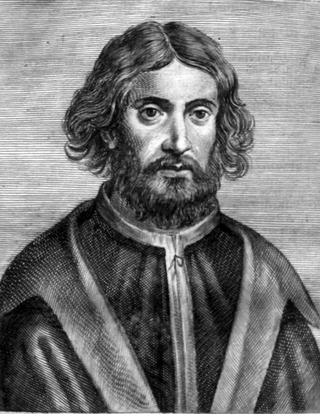
Palma Vecchio, born Jacopo Palma, also known as Jacopo Negretti, was a Venetian painter of the Italian High Renaissance. He is called Palma Vecchio in English and Palma il Vecchio in Italian to distinguish him from Palma il Giovane, his great-nephew, who was also a painter.

The Crucifixion is a life sized painting by the Venetian artist Titian, completed in 1558 and presently hanging in the sanctuary of the church of San Domenico, Ancona. Jesus Christ is shown crucified, with Saint Mary and Saint John standing either side of the cross in the Stabat Mater tradition. The kneeling figure is of Saint Dominic. The canvas was completed during Titian's fifth decade of painting, and is one of the works marking a shift toward his extensive exploration of tragedy and human suffering.

The Madonna della Vittoria is a painting by the Italian Renaissance painter Andrea Mantegna; the painting was executed in 1496.
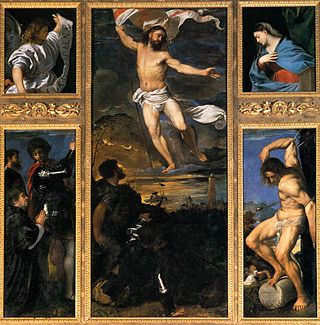
The Averoldi Polyptych, also known as the Averoldi Altarpiece, is a painting by the Italian Renaissance painter Titian, dating to 1520–1522, in the basilica church of Santi Nazaro e Celso in Brescia, northern Italy.
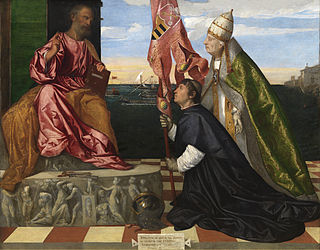
Jacopo Pesaro being presented by Pope Alexander VI to Saint Peter is an oil painting on canvas by Titian, now in the Royal Museum of Fine Arts in Antwerp.
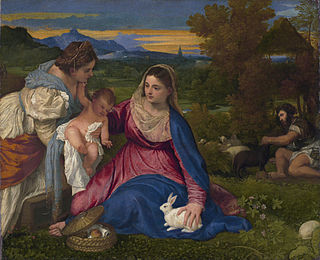
The Madonna of the Rabbit is an oil painting by Titian, dated to 1530 and now held in the Louvre in Paris. It is signed "Ticianus f." and is named after the white rabbit held in Mary's left hand. The rabbit is a symbol of fertility and – due to its whiteness – of Mary's purity and the mystery of the Incarnation, and is also a symbol of her virginity; female rabbits and hares can conceive a second litter of offspring while still pregnant with the first, resulting in them being able to give birth seemingly without having been impregnated.

The Entombment of Christ is a c. 1520 painting by Titian, now in the Musée du Louvre, in Paris.
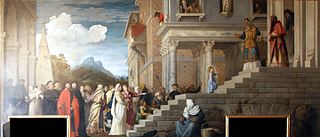
The Presentation of the Virgin at the Temple is a 1534–1538 painting by Titian. It depicts the three year-old Virgin Mary entering the Temple of Jerusalem. It was commissioned by the fraternity based in the Scuola Grande di Santa Maria della Carita, a building later incorporated into the Galleria dell'Accademia, where the work now hangs.

The Scuola del Santo or Scoletta was the headquarters of the Archconfraternity of St Anthony of Padua. It overhangs the churchyard of Basilica of Saint Anthony of Padua, next door to the St. George's Oratory.
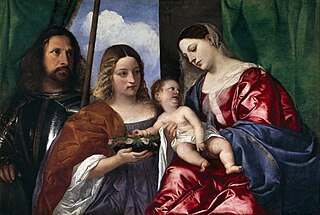
The Virgin and Child with Saints Dorothy and George is a c.1516 oil on panel painting by Titian, now in the Prado Museum in Madrid, to which it was transferred in 1839.

The Pastoral Concert or Le Concert Champêtre is an oil painting of c. 1509 attributed to the Italian Renaissance master Titian. It was previously attributed to his fellow Venetian and contemporary Giorgione. It is now in the Musée du Louvre in Paris.

Madonna and Child with Four Saints or Madonna and Child with Saints John the Baptist, Paul, Mary Magdalene and Jerome is a c. 1516-1520 oil on panel painting by Titian, now in the Gemäldegalerie in Dresden. It belongs to the sacra conversazione genre and features saints John the Baptist, Paul, Mary Magdalene and Jerome.

Madonna and Child with Three Saints or Adoration of the Christ Child with Saints is a c.1519 oil on canvas painting by Titian, now in the Alte Pinakothek in Munich.. From left to right the adoring saints are Francis of Assisi, Jerome and Anthony Abbot.




















